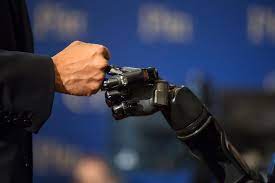Intelligent Artificial Limbs: A Leap Forward in Prosthetic Technology

Introduction
In recent years, advancements in technology have revolutionized the field of healthcare, particularly in the domain of prosthetic limbs. Intelligent artificial limbs, often referred to as “smart prosthetics,” have emerged as a game-changer, offering unprecedented functionality, comfort, and adaptability to individuals who have lost limbs. In this 2000-word article, we delve into the world of intelligent artificial limbs, exploring their design, functionality, benefits, and impact on the lives of amputees.
Understanding Intelligent Artificial Limbs
What are Intelligent Artificial Limbs?
Intelligent artificial limbs are a groundbreaking development in the field of prosthetics. Unlike traditional prosthetic limbs, which are essentially static replacements, intelligent artificial limbs are equipped with cutting-edge technology that mimics the movements and functions of natural limbs. These prosthetics are designed to enhance the quality of life for amputees by providing them with a higher degree of control and versatility.
How Do They Work?
At the core of intelligent artificial limbs is a sophisticated network of sensors, microprocessors, and actuators. These components work in tandem to collect data from the user’s body and the surrounding environment, process it in real-time, and adjust the prosthetic’s movements accordingly. This enables the user to perform a wide range of tasks with greater ease and precision.
The Advantages of Intelligent Artificial Limbs
Restoring Mobility and Independence
One of the most significant advantages of intelligent artificial limbs is their ability to restore mobility and independence to amputees. These prosthetics enable users to walk, run, and even engage in sports activities, which were once considered unattainable for amputees. The sense of freedom and self-sufficiency they provide is invaluable.
Natural-Like Movements
Intelligent artificial limbs are designed to replicate natural movements with astonishing accuracy. Users can perform intricate tasks, such as picking up objects or climbing stairs, with ease. This level of dexterity is a result of the prosthetic’s ability to adapt to the user’s movements and intentions in real-time.
Pain Reduction
Traditional prosthetic limbs often lead to discomfort and even pain for users due to their rigid nature. In contrast, intelligent artificial limbs are equipped with advanced cushioning and pressure-sensitive technology that minimizes discomfort. This significantly improves the user’s overall comfort and reduces the risk of complications.
The Future of Prosthetics
Ongoing Advancements
The field of intelligent artificial limbs is continually evolving. Researchers and engineers are constantly working to enhance the capabilities of these prosthetics. Future developments may include improved sensory feedback, enhanced durability, and even greater integration with the user’s nervous system.
Expanding Accessibility
As technology progresses, there is hope that intelligent artificial limbs will become more accessible to a broader range of individuals, including those in developing countries. This would mean that more people could benefit from these life-changing devices.
Conclusion
In conclusion, intelligent artificial limbs represent a remarkable advancement in prosthetic technology. They offer a lifeline to amputees, providing them with mobility, comfort, and a sense of normalcy that was once unimaginable. As the field continues to advance, we can expect even more incredible innovations that will further improve the lives of those in need.
| https://sway.office.com/3kYhQ5vQZWIKoDrb |
| https://sway.office.com/Wfx6soVbv9fNkT3N |
| https://sway.office.com/2Q7C5cBbe16nqBE2 |
FAQs
- Are intelligent artificial limbs expensive?
- While they can be costly, the benefits they offer in terms of improved quality of life often outweigh the initial investment. Additionally, ongoing advancements may lead to more affordable options in the future.
- Do intelligent artificial limbs require special maintenance?
- Like any technology, they do require some maintenance. However, it’s usually minimal and can be managed with the help of a prosthetic specialist.
- Can anyone use intelligent artificial limbs?
- These prosthetics are designed for individuals with limb loss. However, the specific suitability depends on factors like the level of amputation and the individual’s overall health.
- Do intelligent artificial limbs feel like natural limbs?
- While they provide a high degree of functionality, it’s essential to remember that they do not replicate the sensations of natural limbs entirely. However, they come close to mimicking natural movements.
- Where can I learn more about intelligent artificial limbs and potentially get one?
- You can explore further information and access resources through reputable prosthetic clinics and healthcare providers. Additionally, you can get access to the latest advancements by visiting here.





